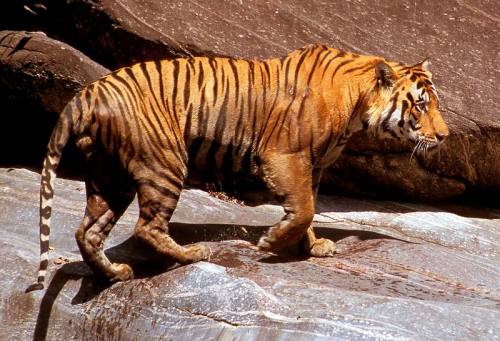Poaching gangs blamed for Tiger losses in Shuklaphanta, Nepal
Cambridge, UK, 3rd July 2008—Shuklaphanta, a Nepalese wildlife reserve that just five years ago boasted the highest density of Tigers in the world, today hosts perhaps just six animals, and the decrease is being blamed on poachers.

In 2004/05 Shuklaphanta in western Nepal held an estimated 27 tigers, at 17 animals per 100 km2, the highest Tiger density in the world. But recent surveys using camera traps in 93 locations recorded just five individual Tigers between December 2007 and March 2008 and WWF estimates there could be just seven animals left in the reserve. Government estimates put the figure at between six and 14 animals.
The dramatic decrease is blamed on poachers, with evidence coming from two recent seizures of Tiger bones inside the reserve as well as skin and bones from adjoining Dhangadi town. The camera traps even captured photographs of armed gunmen inside the reserve, a clear indcation of organized poaching.
Encroachment, illegal hunting, illegal fodder and fuelwood collection, illegal timber collection and high grazing pressure are also considered to have played a lesser role in the decline in Tiger numbers.
In May, TRAFFIC organized an enforcement training workshop for officials from the Government of Nepal in tackling wildlife crime.
Samir Sinha, Head of TRAFFIC India commented: “the news from Shuklaphanta reveals the urgent need to clamp down on organized poaching of Tigers and other wildlife in Nepal and elsewhere.”
“This is an international crisis that can only be dealt with through international co-operation.
WWF is scaling up its community-based anti-poaching operation outside Shuklaphanta, noting that a similar programme entitled “Operation Panthera” outside Nepal’s Chitwan National Park has been a big success, without a single rhino being poached outside Chitwan in the past year.
“We would like to repeat the same exercise around Shuklaphanta and will make sincere efforts to control poaching,” said Diwakar Chapagain, Wildlife Trade Manager of WWF Nepal.
“Although the tiger population in Shuklaphanta is severely depleted now, we strongly believe that it has not reached the point of no return, and that with adequate protection and effective anti-poaching measures the tiger population in Shuklaphanta will bounce back.”
The Tiger monitoring programme at Shuklaphanta is run by WWF in conjunction with the National Trust for Nature Conservation and the Nepalese government Department of National Parks and Wildlife Conservation.



